Learn how to make perfect, crispy Masala Dosa. These South Indian breakfast-style dosa are stuffed with a light and fluffy potato masala, reminiscent of grandma’s home cooking.
Watch how to make Masala Dosa with my step-by-step recipe and video.
From fermenting dosa batter, to learning how to spread thin dosa, as well as dosa cooking techniques, this is the ultimate guide to making Masala Dosa at home.
A love letter to dosa
A meltingly-crisp dosa is one of life’s greatest pleasures.
I remember biting into dosa concealing the fluffiest potato filling throughout my childhood. A bowl of sambar and chutney for dunking.
Growing up in a Gujarati home, this was a special treat from South India’s unique cuisines. Everybody loves dosa!
Since I didn’t grow up sinking my teeth into them regularly, learning how to perfect everything from dosa batter and filling, to mastering the spreading and cooking technique has been a journey of discovery for me.
My nose buried deep in cookbooks, up to my elbows in dosa batter (it really is better when you mix it by hand), and watching pro dosa makers, I’ve developed a recipe that never fails to impress family and friends. Here it is.
What is Masala Dosa?
Masala Dosa is arguably one of South India’s most famous dishes.
It’s made with a thin and crispy crepe-like batter and conceals a spicy potato filling. This dish is also known as Masale Dosey.
Indeed, it’s a perfect breakfast, lunch or dinner option that will forever leave you craving for more.
Hold on to your tawa, I’m about to share some tips on how to perfect this dish, and also showcase some unique versions of this beloved dish.
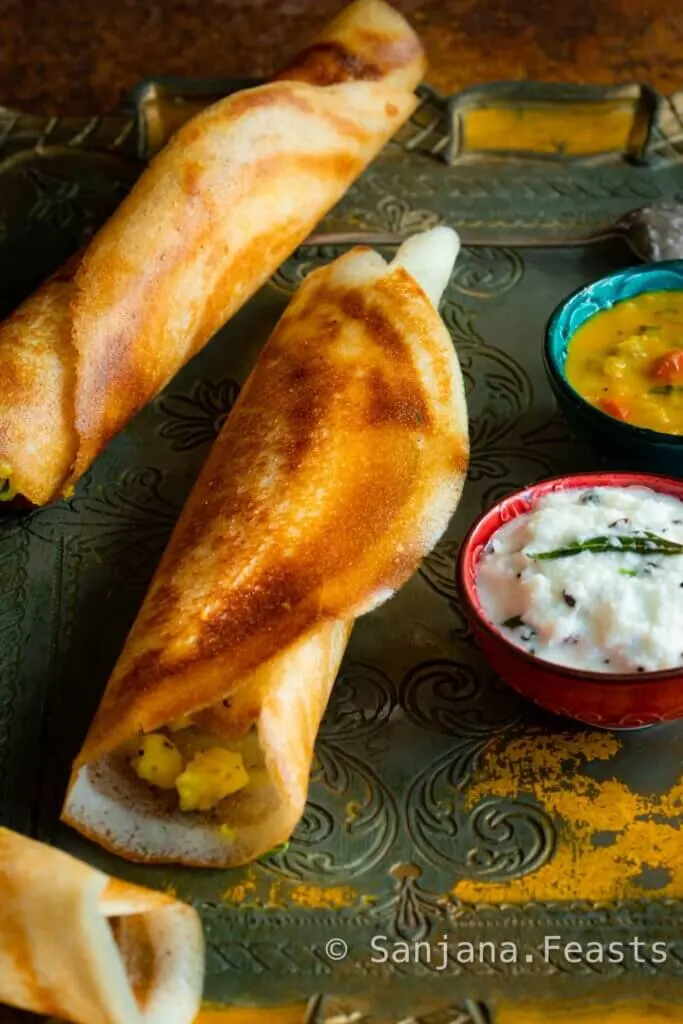
Tips for Making the Perfect Masala Dosa
Making a perfect Masala dosa is all about getting the right ingredients and the perfect cooking technique. Here are some tips to help you make your perfect Masala dosa.
1. Invest in a good quality tawa or non-stick pan
A good quality pan will help you cook the dosa evenly and prevent the batter from sticking to the pan. Opt for the flattest well-seasoned cast iron or anodised aluminium tawa.
In a pinch, you can also use a non-stick frying pan but the dosa may not be as crispy as cast iron-cooked dosa.
2. Choose the right rice

Idli rice (parboiled rice) has the ideal amount of starch for making dosa at home. Add a small amount of Basmati to heighten the aroma.
If you can’t find idli rice, another short grain rice like sona masoori or even Thai Jasmine rice works well.
You will also need white urad daal (skinless black gram).
3. Soak the rice and daal
Soak the rice and white urad daal for at least 6 hours, or up to 8 hours. This will ensure the rice and lentils are well hydrated so they grind and ferment properly.
4. Grind the rice and daal separately before mixing
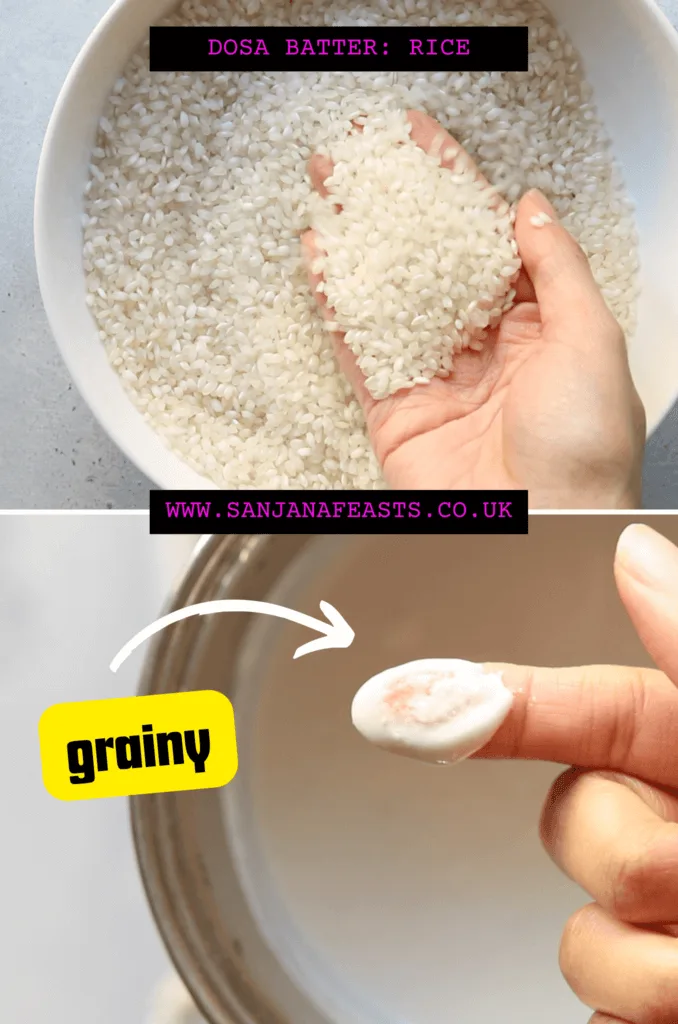
The rice batter should be mostly smooth, but still a little grainy, like that of a gentle exfoliator. This will produce crispy dosa.
It might seem tedious but this is the trick to getting the perfect, spreadable consistency for dosa.
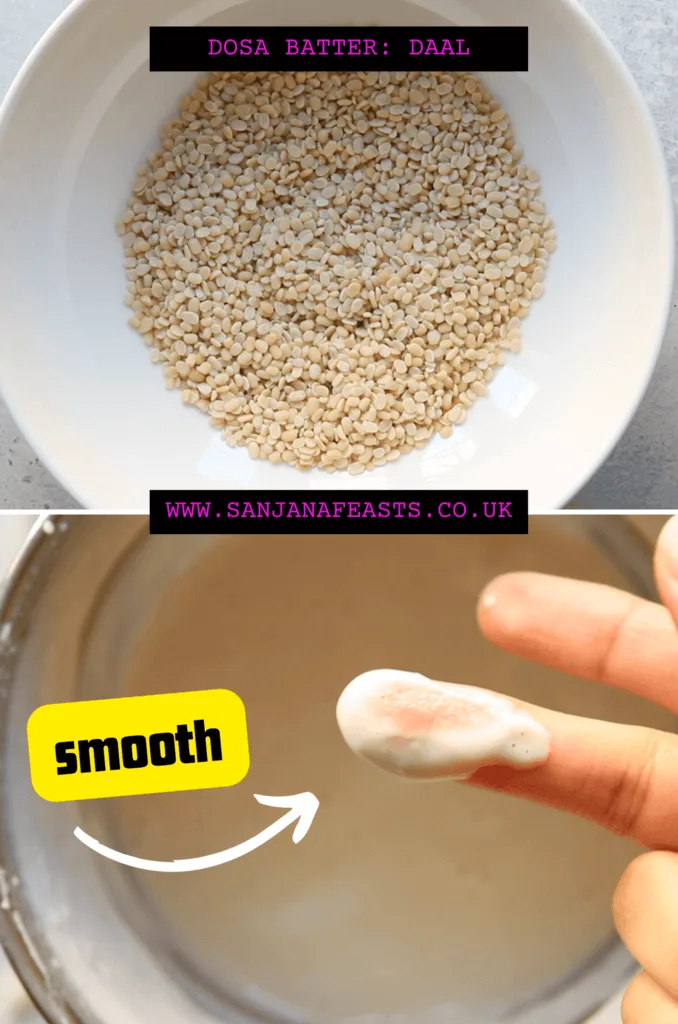
The daal, methi and poha batter should be totally smooth. Its’ viscosity is what gives the batter a uniform body.
Mix the two batters together at the end using your fingers. The dual texture batters create the perfect dosa!
5. Ferment the batter well
The key to making a perfect dosa is to ferment the batter well. 8-10 hours will usually suffice, but if it’s cold, it can take longer.
Fermentation helps to create the right texture and sour flavour of the dosa. Look for billowing air bubbles.
Do not add salt until the very end, after the batter has fermented. Salt will slow down the fermentation process.
Keep the dosa batter in a large, deep bowl, in a very warm place to encourage quick fermentation.
Oh, and before stowing away, whip the batter with your fingers for 3-4 minutes. The heat from your hands warms it for speedy fermentation, too.
6. Use the right batter consistency
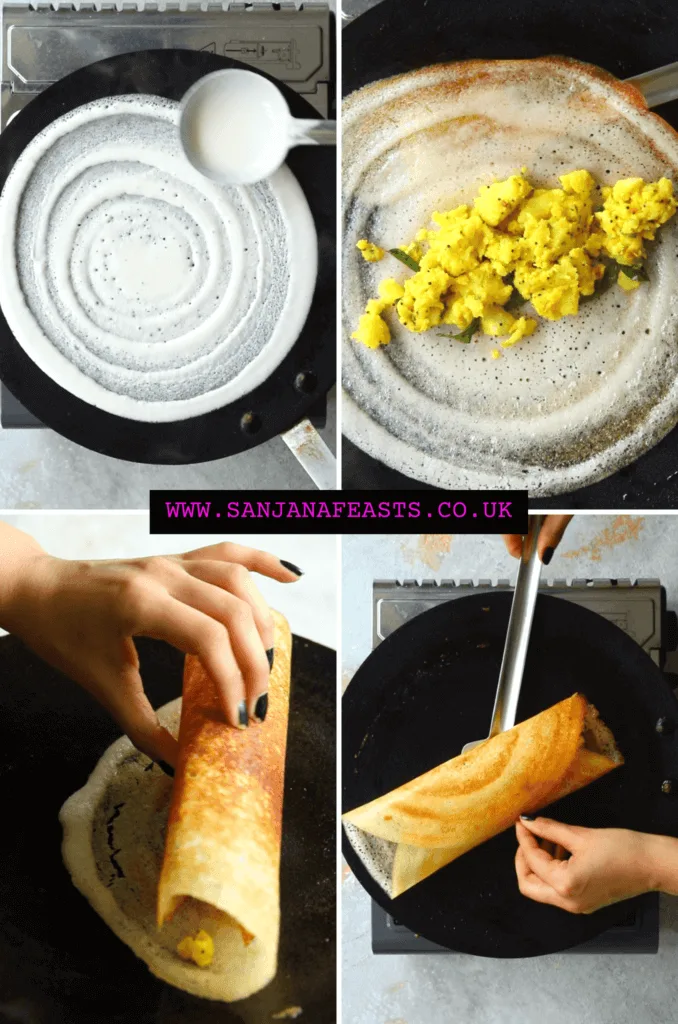
The consistency of the batter plays an important role in making the perfect Masala dosa.
The batter should be thin enough to spread evenly on the pan but thick enough to hold the filling.
Add no, or very little water when grinding the soaked rice and lentils. You can always add more water at the end but you can’t take it away!
7. Spread and cook the dosa over a medium heat
Cooking the dosa on medium flame ensures that it cooks evenly and gets a crispy texture all over the bottom.
Temper the hot pan with a splash of water, then spread a very small amount of oil over the surface of the pan using half an onion or kitchen towel.
Too much oil on a lukewarm pan will result in the batter sliding around all over the place. Not good. Use a medium hot pan (you can turn it down later) and very little oil until the batter is spread (then you can add more oil).
8. Spread the potato filling evenly

The potato filling is a crucial element in the Masala Dosa. Spread it evenly on the dosa to ensure that you get a bite of the filling with every bite of dosa.
9. Serve hot with chutney and sambar

Masala dosa is best enjoyed with coconut or tomato chutney and sambar (a stew-like preparation of daal and vegetables). Serve it hot to enjoy it at its best. They don’t hang around long.
Variations of Masala Dosa

Masala dosa has evolved over the years and has seen many variations. Here are some unique versions of this beloved dish:
1. Rava dosa – Unlike the traditional dosa, rava dosa is made with semolina and rice flour. It’s crispy and thin and is usually served with coconut or tomato chutney.
2. Mysore masala dosa – This version of Masala dosa originated in Mysore, Karnataka. It’s filled with a spicy red chutney made with garlic, red chilli, and onion.
3. Cheese Masala dosa – This is a savoury version of the traditional Masala dosa where Cheddar or mozzarella cheese is added to the potato filling. It’s perfect for cheese lovers!
4. Paneer Masala dosa – In this version, masala paneer is added to the potato filling. It’s a perfect breakfast option for people who love their protein.
5. Onion Masala dosa – This version is made with chopped onion. It’s simple and so flavoursome. Add chillies or gunpowder (podi) for an extra kick.
Masala Dosa is a dish that has gained worldwide recognition for its unique taste and versatility. It’s a perfect example of how Indian cuisine has evolved and adapted to different palates over the years.
Ingredients for making Masala Dosa Batter
Here’s a list of key ingredients you’ll need for making delicious homemade Masala Dosa batter.
Idli rice – parboiled short-grain idli rice is available in South Asian supermarkets
Basmati rice – any long-grain Basmati will do. It adds excellent flavour
Poha – flattened rice flakes. These will make the dosa lovely and crispy. They do not need to be soaked prior to grinding
Methi (fenugreek seeds) – these will add lots of flavour and encourage quick fermentation of the dosa batter
Water – use water sparingly when grinding the dosa batter
Ingredients for making Potato Masala for Masala Dosa
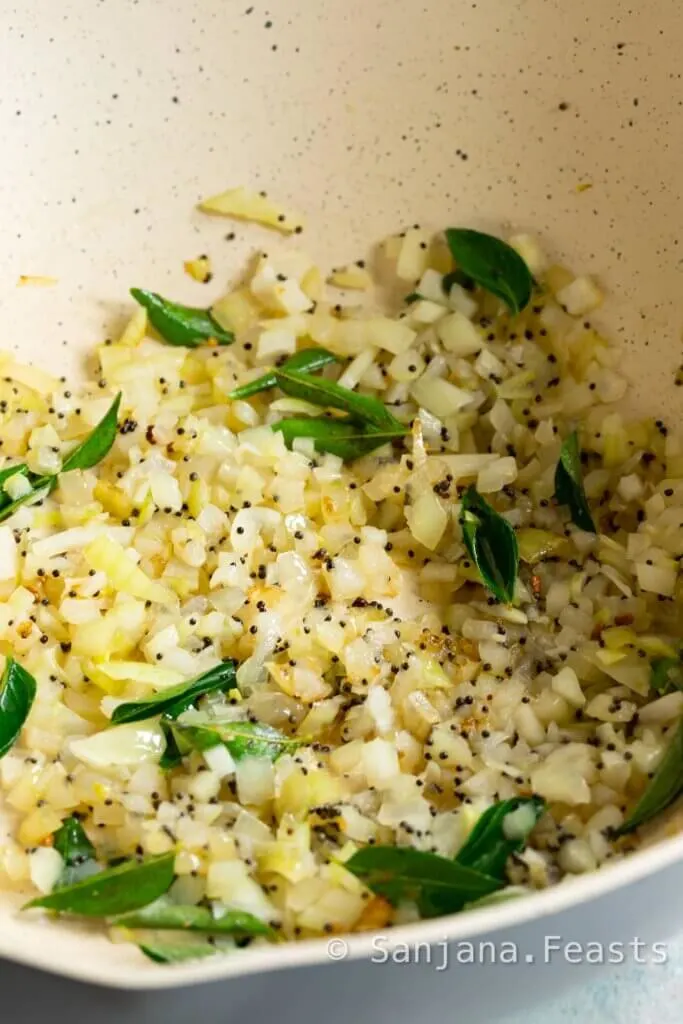


Potatoes – any floury variety works best in this recipe. I use Maris Piper.
Mustard seeds – black mustard seeds are ideal
Asafoetida – also known as hing. This adds a potent alium flavour and aids digestion when cooking or serving with lentils. A little goes a long way.
Curry leaves – wash them well and chop finely for the best flavour. You can also add them whole.
Green chillies – as many as you dare! I use Indian Jwala finger chillies which are quite spicy.
Ginger – grated fresh ginger adds a delicious zap of flavour
Onions – white onions meld into the potatoes for a bright yellow colour but use red onions if that’s what you have. Ensure they’re diced – chunky is fine.
Turmeric – ground turmeric for a colour as bright as spring’s first daffodils
You will also need: oil (any cooking oil or ghee for a richer flavour), salt, fresh coriander leaves and stalks.
Masala Dosa for kids
Masala Dosa is a dish that is loved by people of all ages and is perfect for any time of the day. However, feel free to skip chillies and additional salt for kids.
Are Masala Dosa vegan?
Yes, this recipe is vegan friendly, provided you use oil and not ghee.
Are Masala Dosa gluten free?
This recipe for masala dosa is free from gluten. However, check the label on the asafoetida as many commercial brands contain wheat flour. You can always skip it.
How to make Masala Dosa | Masala Dosa Recipe
Remember, the key to making a good Masala dosa is to get the right ingredients, follow the tips to make it perfectly, and experiment with different versions to find your favourite one.
Truth be told, cooking dosa on a tawa can seem like a daunting task, but with a little practice, anyone can master it. Here is a helpful step-by-step method to help you cook dosa on a tawa like a pro.
Masala Dosa

Learn how to make perfect, crispy Masala Dosa. These South Indian breakfast-style dosa are stuffed with a light and fluffy potato masala, reminiscent of grandma's home cooking. Watch how to make Masala Dosa with my step-by-step recipe and video. From fermenting the dosa batter, to learning how to spread thin dosa, as well as dosa cooking techniques, this is the ultimate guide to making Masala Dosa at home.
Ingredients
For the dosa batter
- 650g idli rice (parboiled short-grain rice)
- 175g Basmati rice
- 1 1/2 tbsp poha (flattened rice flakes)
- 115g urad daal (white)
- 1/2 tsp methi seeds (fenugreek)
- Oil for cooking the dosa
For the dosa masala (potato filling for masala dosa)
- 750g floury potatoes
- 300g onions (about 2 large)
- 3 tbsp oil
- 1 1/4 tsp mustard seeds
- 20 curry leaves (2 sprigs, finely sliced)
- 3 green chillies, minced
- 2 tsp ginger
- 1/2 tsp turmeric
- 1/2 tsp asafoetida
- 3/4 tsp salt
- 1 tbsp lemon juice
- 2 tbsp chopped coriander leaves and stalks
Instructions
- In a large bowl, mix together the idli rice and Basmati rice. Wash in plenty of cold water, changing the water 3-4 times. Top the bowl up with enough cold water to cover the surface of the rice by 3-4 centimetres. It doesn't matter exactly how much, just make sure it's plenty as the rice will bloat and absorb the water as it soaks. Cover the bowl and allow to soak for 6-8 hours.
- In a separate large bowl, mix the urad daal and fenugreek seeds. Repeat the washing process, changing out the water 3-4 times. Top the bowl up with enough cold water to cover the surface of the daal by 3-4 centimetres. It doesn't matter exactly how much, just make sure it's plenty as the daal will also absorb the water as it soaks. Cover the bowl and allow to soak for 6-8 hours.
- Drain both the rice and the daal. Reserve about 100ml soaking liquid from each. Keep the rice and daal separate at this stage.
- In a high-powered blender or wet grinder, grind the rice until it is of a flowing consistency, still with some very fine grains. You might need to scrape the blender down between blitzes to ensure even blade time. Do not add too much water. If your blender is struggling, add a tablespoon of water at a time. The aim of the game is to add as little water as possible. The batter should feel like very fine grains of salt when the batter is rubbed between the thumb and forefinger. If you're a visual learner, watch my recipe video to see the exact consistency required. Transfer the mixture to a large bowl.
- Next, grind the daal and methi mix, along with the poha. This time, you're looking for a very smooth batter with no gritty feeling when rubbed between the thumb and forefinger. Add this to the bowl along with the ground rice batter. Again, try to add as little water as possible whilst grinding.
- Use your fingers to whip the batters together until well combined. Cover tightly and keep the bowl in a warm place for 8-12 hours, until bubbly, risen and fermented. You will be able to smell when it's done (it will have a sour, beer-like smell). If you keep the bowl somewhere cooler, the batter will take much longer to ferment so try to pick a very warm spot. Also, ensure your bowl is deep enough as the batter will rise up and overflow in a small bowl.
- Once the mixture has fermented. add salt. Do not add salt prior to the batter reaching the correct stage as it will delay the fermentation process. For the total amount of batter, I added about 1 1/2 tsp salt but start off with less and taste before adding more. This is a personal choice.
- Adjust the consistency of the batter with a little bit of fresh water at a time. Beat with a ladle and check if it is of a thick, flowing consistency. Again, please refer to the video if you're not sure what I mean by this. When dropping the batter from a height it should billow off the ladle and flow like lava, slowed by the air bubbles inside. This is why it's important not to add too much water when grinding; You can always add water, but you can't take it out. The flavour and smell should be a happy kind of sour.
- Congrats, your dosa batter is now ready. Keep it covered and at room temperature until you're ready to use it. If you're not using it on the same day, you can also store it in the fridge for up to 3 weeks. It will become more sour over time, which adds to the delicious flavour.
- To make the dosa masala (potato filling for dosa)
- Boil the whole potatoes in plenty of water until very tender. Alternatively, microwave until soft (I usually microwave as it's so easy). Allow the potatoes to cool a little, and then peel off the skins. Roughly chunk the potatoes, mashing a few with a fork as you go. They should be rugged and fluffy. Set aside.
- Heat the oil in a large pan. Add the mustard seeds and wait for them to finish popping. Tip in the asafoetida, curry leaves, chillies and ginger. Give this a brief stir before tipping in the onions, turmeric and salt. Cook for 6-7 minutes until the onions have softened and just started turning brown at the edges.
- Tip the potatoes in with the onions and toss to coat the potatoes with all the masalas. Cook for a further 4-5 minutes, stirring all the time. Switch the heat off and add the coriander and lemon juice. Give the masala a final mix and set aside.
- To cook the Masala Dosa
- For cooking Masala Dosa, a large, flat tawa is preferable. Cast iron and anodised aluminium will give you the most golden finish, but they can be tricky to work with (the dosa can stick if the pan isn't properly seasoned). In any case, ensure cast iron is very well seasoned if you choose to use it. I use cast iron and anodised aluminium interchangeably. You can also make the dosa in a non-stick frying pan but the colour may not be quite as golden brown. Do not use ceramic-coated pans or stainless steel. Make the dosa as big or as small as you like. Start small if this is your first go.
- Heat the pan until it's smoking hot, a few minutes will do. Turn the heat down and flick it with some water to temper the heat. The water should sizzle and evaporate quickly. Rub the pan with an onion half dipped in oil (poke it onto a fork if you like). This is said to add flavour and stop the dosa from sticking. You can also just wipe the pan quickly with a paper towel dipped in oil.
- Pour the batter: Using a ladle, pour a spoonful of dosa batter on the tawa's hot surface. Start from the centre of the tawa and use the ladle to spread the dosa batter thinly and evenly, in a circular motion.
- Add a teaspoon of oil around the sides of the dosa and on top of it. This will help to cook the dosa evenly, with a golden brown colour and also prevent it from sticking to the tawa. Cook over a medium-low heat for 3-4 minutes for the crispiest dosa.
- Once you spot the dosa starting to brown, the edges should start lifting away from the pan. If using cast iron or anodised aluminium, you might need to help it along using a spatula. Try not to prise the dosa from the pan - it will tell you when its ready by coming away by itself.
- Spoon a few dollops of the potato masala filling on top of the dosa and carefully begin to roll it into a cylinder. The underneath should reveal a beautiful golden brown colour. Remove the rolled masala dosa from the tawa and serve immediately with coconut chutney and sambar.
- Repeat the process for the remaining batter, wiping the pan with a lightly-oiled paper towel or cut onion each time. Remember to heat the pan sufficiently each time. Keep the dosas warm in a low oven for 15-20 minutes if you need to. Any longer and they will dry out.
Notes
Use this dosa recipe to make plain dosa (Sada Dosa), ghee dosa, butter dosa or even Uttapam.
Spread the batter very thinly for an excellent Paper Dosa.
The dosa batter can be made in advance and kept in the fridge for up to 3 weeks. You can prepare the potato filling 24 hours ahead, if necessary.
Experiment and try adding your favourite toppings to make customised dosa.
Masala Dosa are best eaten straight away. If you must reheat them, try popping them back onto the tawa or in a frying pan with a little butter or ghee to crisp them up again. Be sure to heat through thoroughly.
Nutrition Information:
Yield: 6 Serving Size: 1Amount Per Serving: Calories: 512Total Fat: 12gSaturated Fat: 1gTrans Fat: 0gUnsaturated Fat: 10gCholesterol: 0mgSodium: 572mgCarbohydrates: 89gFiber: 7gSugar: 5gProtein: 12g
If you like this, you’ll love my recipe for 4 Indian Chutney Recipes

More recipes to savour and share
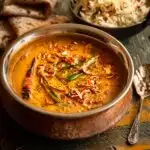
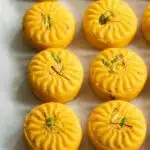
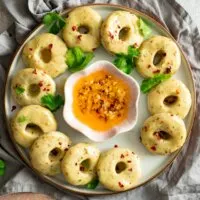
Love Sanjana


Dal Makhani Recipe (Slow Cooker Instant Pot) - Easy Indian Recipes
Thursday 18th of January 2024
[…] They’re available whole or split with their skins on or off. The white (husked) variety of urad is commonly used for making Dosa. […]
Gluten Free Roti (3 Ingredients!) - Indian Breads - Sanjana.Feasts
Thursday 8th of June 2023
[…] bhakri, dosa and cheela are some examples of flatbreads and pancakes served at meal […]